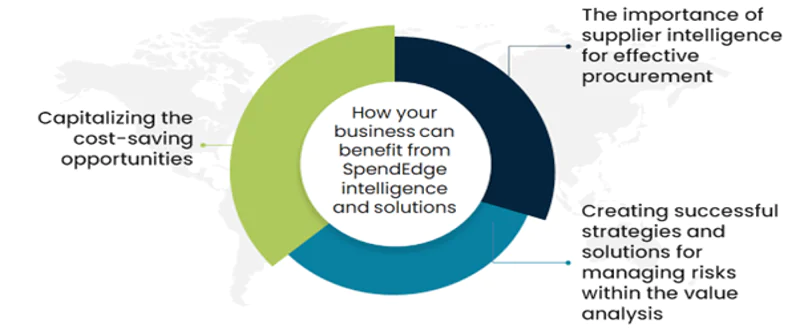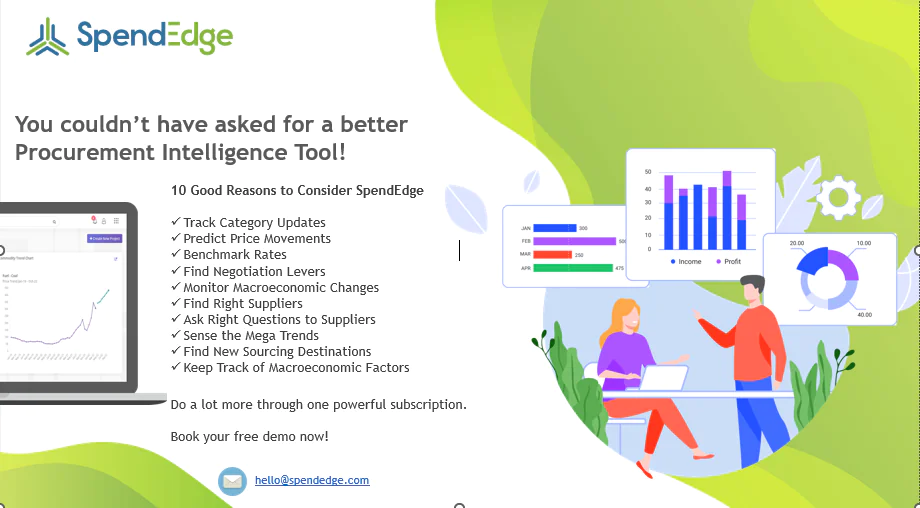In the field of procurement, the accumulation of expenses related to goods and services is a significant consideration, underscoring the importance of implementing efficient approaches to manage expenses within manageable limits. Whether it involves searching the market for improved bargains, optimizing workflows, or engaging in negotiations with suppliers, the implementation of cost-cutting techniques within the procurement is essential for astute business proprietors.
Procurement analysis holds significance for every organization, regardless of its scale and revenue. As a business expands, its organizational intricacies grow as well, necessitating the establishment of a robust procurement analysis framework to provide practical insights and support informed decision-making process. The procurement analysis also has the potential to enhance profit margins, improve competitiveness, support long-term financial stability.
What is a procurement cost analysis?
Procurement analysis helps you understand your expenses and their distribution within your procurement department or business. It allows you to have better cost control and anticipate future expenses. It involves examining the data generated in your procure-to-pay process and refining it to gain insights into your spending.
Effective procurement analysis and cost-reduction strategies
Building a resilient procurement contract management system
Procurement contract management that is efficiently holds significant importance in attaining the best outcomes for businesses. By embracing best practices and utilizing suitable tools or applications, organizations can reap a variety of benefits. Including improved compliance, minimized risks, and streamlined processes. Contracts involve numerous intricate components. Therefore, proficiently overseeing them necessitates meticulous attention to detail and specialized expertise. Allocating resources to proficiently manage procurement contracts enables organizations to avoid typical challenges such as stakeholders miscommunication, sluggish approval procedures, and inefficiencies within the procurement process.
The increased significance of procurement benchmarking
Amidst the ongoing disruptions impacting supply chains and suppliers, procurement professionals are increasingly focused on evaluating their organization’s performance and its relative standing. Benchmarking provides a competitive advantage that empowers organizations to navigate changes, faster adaptability, growth, and resilience. This helps in identifying areas for improvement, optimizing resource allocation, enhancing efficiency, and evaluating spend analysis. By analyzing benchmarks, companies can make informed decisions, set realistic goals, and implement strategies to stay competitive and achieve excellence in their procurement operations.
Strategies to reduce risk lead to business success
Risk management in procurement involves identifying and analyzing, and mitigating potential risks that could impact the procurement process. It is crucial to anticipate risks related to suppliers, contracts, pricing, quality, and more. By addressing these risks proactively, organizations can make informed decisions, develop contingency plans, and ensure successful procurement outcomes.
Unlocking Benefits: Procurement Analytics
- Procurement analytics isn’t confined to procurement alone; its benefits extend across the organization. It’s not just about optimizing procurement spend process; it’s about leveraging actionable insights to drive strategic decisions.
- In the realm of procurement analytics, value manifests in timely, precise, and actionable insights. By harnessing procurement data visibility, organizations empower themselves to make informed decisions spanning from budget management to risk mitigation.
- Procurement teams can utilize analytics to enhance strategic supplier relationships, refine purchasing practices, and drive cost reductions. Automation of P2P workflows liberates time for strategic pursuits and relationship management.
- From spend optimization to supply base management, procurement analytics platforms offer a comprehensive toolkit. They facilitate benchmarking at various levels, aiding in forecasting and performance development.
- Procurement analytics isn’t merely about tracking spending; it’s about maximizing bottom-line impact. By scrutinizing expenses and spending rules, organizations can uncover areas for consolidation and prioritization.
- In essence, procurement analytics serves as a catalyst for organizational growth, enhancing procurement strategy and fostering fruitful vendor partnerships. It’s not just about numbers; it’s about shaping a smarter, more efficient future.
Best practices used by procurement teams regardless of size and stage
Formalizing procurement spend process
The initial step in saving money is to establish a standard procure-to-pay (P2P) workflow. Formalizing the procurement function assists stakeholders in understanding the precise process from requisition to payment. This also aids in setting spending rules, creating accountability at every stage of the process, and forms the basis of effective contract management.
Enhancing procurement data visibility
To save on procurement expenses, a detailed understanding of where the money is being spent is needed. By using a modernized, automated procurement analytics platform, gain complete visibility into spending beyond simple “revenue minus expenses” accounting when the books are closed . This complete data transparency allows data analysis in a meaningful way, including category, department, product type, supply base, tax nexus, geography, and more. Once the spending data is extracted and refined, a procure-to-pay (P2P) platform can compile it into helpful dashboards to visualize how the data is working. This will enable to surface actionable insights and improve the procurement strategy more easily.
Building strategic supplier relationships
Vendor partnerships are advantageous for all involved as they can lead to significant cost reductions. By establishing relationships with preferred suppliers for high-volume and recurring purchases, you can benefit from volume discounts and greater purchasing flexibility. Strategic vendor partnerships also save time by eliminating redundant work, reducing due diligence, and streamlining the negotiation and onboarding process when bringing on a new vendor. With a solid supplier management process paired with a well-curated list of preferred vendors, companies can take advantage of the best deals with considerably less hassle.
Balance inventory and sourcing practices
Inefficient sourcing and inventory management can result in various monetary costs. For instance, delays in delivery and shortages in inventory can lead to extended production timelines. Rush orders may incur expediting fees, quality issues, and invoicing mistakes. By reducing these issues, a company can save many hours previously spent on troubleshooting, while also stabilizing its cash flow.
Determine cash leaks with spend analysis
Having a formal process in place makes it easier to identify spending leaks in the workflow. By using a documented, repeatable process, you can eliminate common money-wasting culprits such as non-preferred vendor use, maverick spending, and over-ordering. Centralizing the procurement process enables eliminating one-off purchases, unplanned spending, and over-ordering by giving everyone access to the purchasing guidelines. It also allows for better understanding of total costs and savings through strategic sourcing.
Automation entails eliminating mistakes and busywork
When the Purchase to Pay (P2P) process is carried out manually, it can lead to various errors such as missed or late payments, over or underpayments, mismatched information, and incorrect data entry. These issues have the potential to result in late fees, disrupted orders, delayed closing activities, or other costly consequences. By integrating supplier invoicing, reconciliation, and payment into an automated system, these risks can be eliminated, creating a more user-friendly and trackable process. Additionally, this automation significantly reduces the time spent by the Finance team on repetitive tasks, allowing the Accounts Payable staff to engage in more meaningful projects.
How SpendEdge can help you with procurement analysis?

The importance of supplier intelligence for effective procurement
Our procurement advisors provide guidance and expertise in optimizing organization’s procurement process. Our experts offer strategic insights, recommend best practices, and help in developing procurement strategies that align with organization’s goals. Additionally, our procurement advisors help organizations make informed decisions about which suppliers to engage with and how to manage relationship effectively.
Creating successful strategies and solutions for managing risks within the value analysis
Our procurement specialists assist in creating an efficient value analysis strategy for procurement process. Value analysis in procurement involves assessing the spend and benefits of different options to ensure that the selected choice delivers the best value for the organization. Our advisors help in analyzing supplier offerings, negotiating terms, and optimizing procurement decisions to achieve cost savings and maximize value.
Capitalizing the cost-saving opportunities
Our experts focus on reducing costs through strategies like addressing price deviations, while also ensuring that inventory levels are optimized to prevent both overshooting and falling short. The holistic insights provided by our experts helps organizations to measure the actual performance with the standard performance and take corrective actions, as well as achieve cost savings and maintain operational efficiency.
Common types of analysis in procurement include
- Descriptive Analytics involves analyzing procurement data to provide insights into historical trends and performance. This analysis focuses on summarizing and understanding past purchasing activities.
- Diagnostic Analytics goes a step further by interpreting procurement data to uncover the root causes and factors that have led to specific outcomes or events in the past. It helps in understanding why certain procurement patterns or anomalies occurred.
- Predictive Analytics uses historical data and statistical algorithms to identify trends and patterns in procurement data. This information is then utilized to forecast and predict future procurement performance and outcomes.
- Prescriptive Analytics leverages predictive models and algorithms based on procurement data to provide recommendations and insights for decision-making. This involves using data-driven insights to optimize procurement strategies and processes.
Success Story, How we helped our client with procurement analysis
Our client is a is a well-established company in the FMCG sector, specializing in the production and distribution of a wide range of consumer goods, including food, beverages, and personal care products.
The client is facing challenges in its procurement processes, including supplier fragmentation and excessive stock levels of certain products while shortages of others were leading to increased storage costs and potential product wastage. Additionally, fluctuations in raw material prices were affecting the company’s cost structures and profitability.
Our procurement advisors implemented a series of strategic changes that focused on process optimization, value analysis, spend analysis, and collaboration. Our experts analyzed client’s supplier base and consolidated relationships with key suppliers. This reduced procurement costs, improved negotiation power, and fostered stronger partnerships.
Furthermore, our experts provided the insights or data analysis to procurement team to adjust orders based on actual market demand, reducing overstocking and stockouts. Our procurement specialists also actively monitored market trends, geopolitical developments, and supply chain disruptions. This proactive approach allowed client to anticipate potential challenges and develop contingency plans.
The procurement solutions offered by our experts helped our client to consolidate their supplier relationships and optimizing procurement. Our insights helped client in maintaining improved inventory management, resulting in enhanced working capital management and proactive risk management strategies minimized the impact of supply chain disruptions, ensuring uninterrupted operations.

Author Details
George Mathew
Associate Vice President, Sourcing and Procurement Intelligence
George is a procurement specialist at Infiniti Research and provides advisory services to clients across the pharmaceutical, CPG & FMCG, energy, and automotive sectors. He specializes in the procurement areas of industry benchmarking, cost modeling, rate card benchmarking, negotiation advisory, and supplier intelligence.




